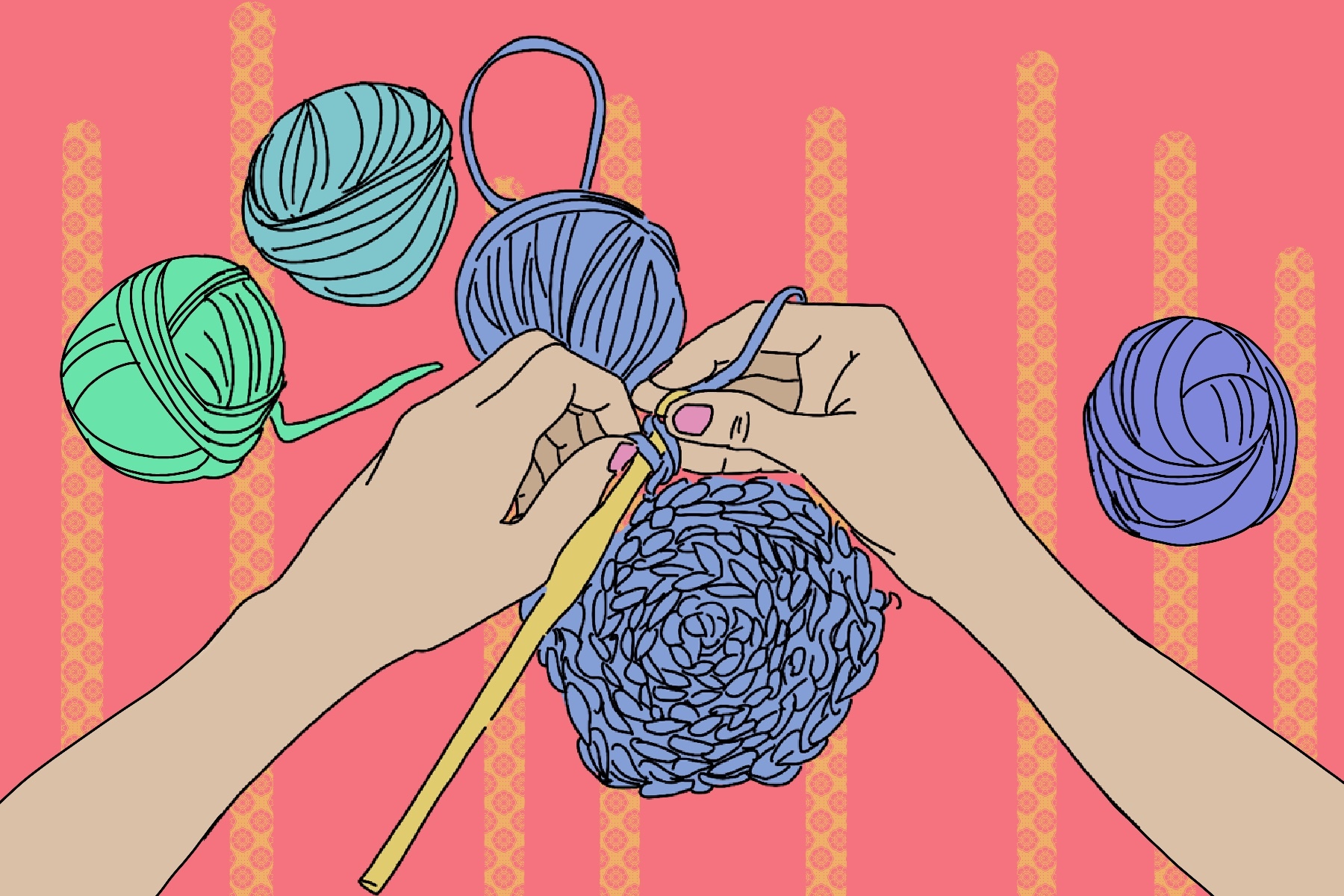Bikini tops and bumblebees, market bags and mushroom hats, washcloths and water bottle holders; if you can dream it, you can crochet it. What started as a trend during the early days of the pandemic appears to be here to stay in the fashion world. Until 2020, crochet was stereotypically reserved for grandmas. This changed after COVID-19 and lockdown. At the beginning of the pandemic, hundreds of thousands of people were left with nothing to do but twiddle their thumbs and wallow in existential dread. What better way to block out the anxiety than to pick up a hook and some yarn? As a result, the craft exploded on TikTok. If you happened to miss out on this era, this article by Mashable outlines how crocheters found both popularity and solace by showing off their creations on TikTok.
Crocheted items used to primarily be found on Etsy, crafted and sold by artists directly. Unfortunately, when something becomes fashionable, cheaper and less ethical knockoffs always follow, and crochet is no exception. Fast fashion sites like SHEIN and large retailers like Target have hopped on the crochet trend, undercutting Etsy sellers by significant margins.
The craft is relaxing and rewarding, but as wearable crochet garments become more popular, it is essential to understand the labor that goes into producing these items. It may be a hard pill to swallow, but most crocheted items should not come cheap. Here’s something that may horrify you: It is impossible for crocheted items to be replicated by machines. While knitting machines exist, the only way to crochet is by hand. The stitches are just too intricate.
That means this $15 crocheted top from SHEIN was made by hand. If I were to make this for myself, the materials alone would cost $15. After factoring in the cost of labor (let’s say five hours, if you’re extremely quick and crocheting nonstop), this top should cost at least $60 if the maker was paid a measly $10 an hour for their labor. On average, SHEIN laborers are paid much less than that. The cheery reviews raving about the top take on a deeply unsettling tone once you stop and think about the work that was put into it. A real person sweated over that top and was likely paid pennies in return.
By purchasing the cheapest option, there is a high chance that your dollar is supporting deeply unethical labor practices. Many people are not used to spending more than $20 on a shirt, so dropping more than $50 on a crocheted top might seem ludicrous. The reality is that if you want to compensate artists fairly for their work, you’re going to have to get used to a higher price tag. Granny squares are some of the most popular crocheted items right now, and can be made into everything from bucket hats to blankets. A granny square takes the average crocheter around 30 minutes to make, and a top like the one from SHEIN would require around 20 granny squares to complete. That’s over 10 hours of work.
These facts are not meant to shame you for your shopping choices; if you’re interested in crochet, this is an opportunity to think more deeply about where your clothes come from. In America, we are often completely alienated from the processes (and people) that create the clothes we wear. It is all too easy to ignore that there is a real person stitching our garments together. We drive to the store, we look through the racks of neatly hung items, we try on an outfit, we take it home and that’s that. Handmade crocheted items are a whole other ballgame and must be approached with an entirely different, anti-consumerist mindset.
If you want to partake in the crochet trend, value quality over quantity. Having a few well-made items produced ethically will pay off in the long run. Purchasing from a smaller, independent crafter means not only will your item be more unique and guilt-free, it will also be more durable. A fast-fashion crochet piece made with low-quality yarn and shoddy stitches will fall apart after a few washes, while a more expensive, slowly crafted piece will last years. Over time, you will actually save money. When you wear crocheted items from sites like SHEIN, you must also wear the guilt that comes from knowing your purchase directly contributed to a deeply harmful and wasteful industry.
You could spend all day investigating brands to determine their ethicality. Or, you could pick up a hook and teach yourself to crochet. This is the most ethical option of all — you know exactly where the product is coming from, and the only person you have to worry about overworking is yourself.
I won’t lie and pretend it’s ridiculously easy. There is a learning curve, especially if you have never considered yourself to be a crafty person. The most important thing to remember is that it is okay to make something that looks like crap. You are going to miscount your stitches. You are going to get frustrated. Your final product is probably going to be horribly lumpy and misshapen, and you may never want it to see the light of day. But that’s how you learn. Even the most talented crocheters had to start somewhere.
Bella Coco’s series on “How To Crochet For Absolute Beginners” is one of the most popular places for newbies to start, but there is no end to free resources on how to pick up the hook. Type “crochet beginner” into the YouTube search bar, and you will find a dizzying array of results. Learn the most basic stitches (single, double and treble), learn how to change yarn colors, and soon you’ll be a verified pro. The best beginner projects are washcloths. Pick up some cotton yarn and make little squares to your heart’s content. After your third square, the edges will stop being wonky and will start resembling something close to perfection. Keep in mind: The beauty of handmade items is that they are handmade, flaws and all.
The YouTube channel “ikoxun” should be your next stop after you feel comfortable with the basic stitches. She provides step-by-step visual guides on how to crochet trendy items like shrugs and granny square pants, as well as how to modify the patterns to fit your body perfectly. It’s shockingly easy to tailor the items to fit your body like a glove. SHEIN could never. As your skills develop, you will slowly create a collection of items made to suit your body and your tastes. You will have spent hundreds of hours producing something with your own two hands, time that might otherwise have been spent aimlessly doom-scrolling. It’s cheap and intensely rewarding. Creation is an inherent human need, and crocheting is just one way to fulfill that void. Once you get the hang of it, you won’t be able to resist knitting, and embroidery, and sewing, and felting, and — you get the picture.
Before you head to Jo-Ann’s, there is one more thing to consider when talking about sustainability in the context of crochet. Although producing your own clothing is much more sustainable than purchasing fast fashion, it is not completely guilt-free. The cheapest and most accessible yarn on the market is acrylic. Acrylic yarn is attractive for several reasons: It is more budget-friendly than most natural fibers, it is easy to find (large craft store chains like Jo-Ann’s and Michael’s will almost exclusively stock acrylic yarns) and it is durable as well as washing machine safe. That durability comes with a cost. Acrylic yarns are made from petroleum, which means it is not biodegradable. Every little scrap of yarn ends up in a landfill for decades upon decades.
Well, great. What am I supposed to do if I can’t afford to buy ethical products, but I can’t afford to crochet sustainably? The solution is a little more complex, but that’s why sustainable fashion is often referred to as “slow” fashion. It takes longer to get there, but it’s worth it in the end to know that your choices did not actively harm the world around you.
Natural fibers are the most sustainable choice. They include yarns made from naturally derived materials like wool, cotton, silk, linen, bamboo, or (my favorite) hemp. These materials will degrade naturally over time. They also feel better on your body. In an age where we risk consuming up to a credit card’s worth of microplastics per week, it feels good to know that I am not intentionally putting more plastic on my skin. Natural fibers are more expensive and sometimes harder to find in stores, but that doesn’t mean it’s impossible to source them.
First, search for a locally owned craft store near you. Not only do they carry more yarn made from natural fibers, they may also carry yarns spun by local crafters using local materials. There is something so cozy about knowing exactly where your materials come from. If that isn’t an option, hit up thrift stores. Facebook Marketplace and estate sales are always full of people pawning off their yarn stashes on the cheap. If you’re feeling adventurous, you could thrift a sweater or another knit garment and unravel it, then rewind the yarn into a ball.
If you are unable or unwilling to reduce your use of acrylic yarn, just try to be mindful of your waste while crocheting. When snipping off the ends of a project, save your scraps and keep them in a jar to use as stuffing for projects like pillows and amigurumi. You will sleep better at night knowing your scraps will never end up in the ocean or in a landfill. Additionally, be mindful of the tools you choose to use. Invest in metal or wooden hooks rather than plastic — the price difference is minuscule. Instead of buying the cheap plastic stitch markers that look like baby teething rings, use safety pins or even old hoop earrings. Your wallet and the planet will thank you in the long run.
Crocheting sustainably is easy, but it is a practice in patience. You may see other crafters with walls and walls of acrylic yarn displayed in a tantalizing rainbow, but don’t let the excess fool you into making poor purchases. Make crochet a slow, intentional hobby. Actively disengaging from the consumerist propaganda machine that screams “more, more, more” will quiet your mind and make you a more fulfilled person. As your skills develop, so will your pride in your new, handcrafted wardrobe. Making ethical, sustainable choices doesn’t just benefit the planet; it nourishes your soul.

















